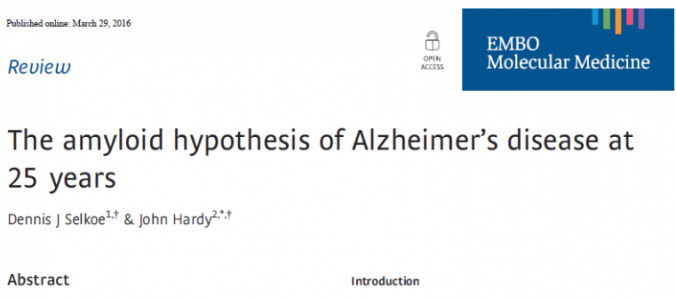The amyloid hypothesis of Alzheimer's disease at 25 years.

EMBO Molecular Medicine. 2015, mar, 29.
Selkoe DJ, Hardy J.
Abstract:
Despite continuing debate about the amyloid β-protein (or Aβ hypothesis, new lines of evidence from laboratories and clinics worldwide support the concept that an imbalance between production and clearance of Aβ42 and related Aβ peptides is a very early, often initiating factor in Alzheimer'sdisease (AD). Confirmation that presenilin is the catalytic site of γ-secretase has provided a linchpin: all dominant mutations causing early-onsetADoccur either in the substrate (amyloid precursor protein,APP) or the protease (presenilin) of the reaction that generates Aβ. Duplication of the wild-typeAPPgene in Down's syndrome leads to Aβ deposits in the teens, followed by microgliosis, astrocytosis, and neurofibrillary tangles typical ofAD Apolipoprotein E4, which predisposes toADin > 40% of cases, has been found to impair Aβ clearance from the brain. Soluble oligomers of Aβ42 isolated fromADpatients' brains can decrease synapse number, inhibit long-term potentiation, and enhance long-term synaptic depression in rodent hippocampus, and injecting them into healthy rats impairs memory. The human oligomers also induce hyperphosphorylation of tau atAD-relevant epitopes and cause neuritic dystrophy in cultured neurons. Crossing humanAPPwith human tau transgenic mice enhances tau-positive neurotoxicity. In humans, new studies show that low cerebrospinal fluid (CSF) Aβ42 and amyloid-PETpositivity precede otherADmanifestations by many years. Most importantly, recent trials of three different Aβ antibodies (solanezumab, crenezumab, and aducanumab) have suggested a slowing of cognitive decline inpost hocanalyses of mildADsubjects. Although many factors contribute toADpathogenesis, Aβ dyshomeostasis has emerged as the most extensively validated and compelling therapeutic target.
Mais informações: http://www.ncbi.nlm.nih.gov/pubmed/27025652
01 de abril de 2016 às 16:39
 Newsletter
Newsletter  RSS
RSS